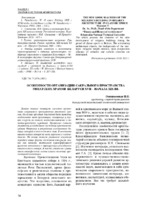| dc.contributor.author | Ожешковская, И. Н. | ru |
| dc.coverage.spatial | Минск | ru |
| dc.date.accessioned | 2021-05-08T11:46:59Z | |
| dc.date.available | 2021-05-08T11:46:59Z | |
| dc.date.issued | 2021 | |
| dc.identifier.citation | Ожешковская, И. Н. Особенности организации сакрального пространства униатских храмов Беларуси XVII – начала XIX вв. = Features of the organization of the sacred space of uniate churches in Belarus of the 17th - early 19th centuries / И. Н. Ожешковская // Архитектура : сборник научных трудов / редкол.: А. С. Сардаров (гл. ред.) [и др.]. – Минск : БНТУ, 2021. – Вып. 14. – С. 34-39. | ru |
| dc.identifier.uri | https://rep.bntu.by/handle/data/91476 | |
| dc.description.abstract | Данная статья посвящена изучению организации сакрального пространства униатских храмов. На основе архивных изысканий были выявлены особенности этой организации, основанные в первую очередь на синтезе восточнославянских и западноевропейских традиций. Проявление синтеза отразилось в комбинации элементов христианских храмов. Например, в устройстве в иконостасе боковых алтарей у икон местного чина. В сочетании католического алтаря по типу лоретто и с иконостасом. На основе синтеза униатское искусство породило новые формы элементов интерьера, такие как колоссы, являющиеся трансформацией высокого иконостаса с двухъярусным ретаблумом католического алтаря. А также униатские храмы имели специфические места культа на основе оригинальной композиции. | ru |
| dc.language.iso | ru | ru |
| dc.publisher | БНТУ | ru |
| dc.title | Особенности организации сакрального пространства униатских храмов Беларуси XVII – начала XIX вв. | ru |
| dc.title.alternative | Features of the organization of the sacred space of uniate churches in Belarus of the 17th - early 19th centuries | ru |
| dc.type | Article | ru |
| local.description.annotation | This article is devoted to the study of the organization of the sacred space of the Uniate temples. On the basis of archival research, the features of this organization were identified, based primarily on the synthesis of East Slavic and West European traditions. The manifestation of synthesis was reflected in the combination of elements of Christian churches. For example, in the arrangement in the iconostasis of the side altars near the icons of the local rank. In combination with a Catholic altar in loretto style and an iconostasis.On the basis of synthesis, Uniate art gave rise to new forms of interior elements, such as colossi, which are the transformation of a high iconostasis with a two-tiered retumble of a Catholic altar. And also Uniate temples had specific places of worship based on the original composition. | ru |

